|
Kicking Bananas while Flying Forbidden!
But not even on the runway of Mirador El Time was it much better. A relatively strong wind blew, which were it a normal take off wouldn't matter, but here it was taking off from a jagged cliff. Unfortunately it's not possible to take off with a paraglider on the East Side, for Mila it was too strong and Standa was put off by the thickening cloud base a few meters above start. Once again we got into the car and drove down to the beach at Puerto Naos.
Along the way we attempt unsuccessfully to buy something in the city of Los Llanos, almost devoid of people after the long carnival night. In Puerto Naos we briefly look at the landing ground, unload Mila who'e going to fry himself on the beach with the wife and his own at that ( if voluntarily I don't know). After the requisite wandering through the banana plantation we arrive at the spot. To my surprise however, I'll be flying alone because Standa has to take some pictures from the ground. Excellent excuse!
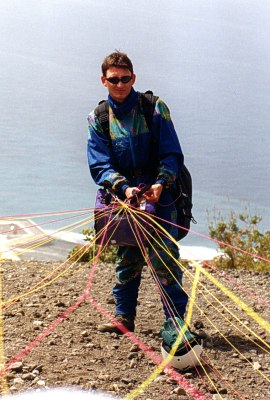
The landing area is a relatively small, almost horizontal field about 30x40m on the edge of a grassy, not too steep slope. Only the cactuses just below the runway make me a little nervous. Shortly after us a local pilot arrived along with some German lady retiree. Before I could manage to prepare my paraglider he was already running the edge. It's true that his organization was superb. His baby spread out the paraglider, shook the cords loose, strapped the passenger into the seat, helped them into the air and also took the car down. I didn't wait for anything and quickly followed him. I was in the air very quickly. Before I was able to finish inflating the shut half to the paraglider I was already 20m above the ground with the variometer happily whistling away.
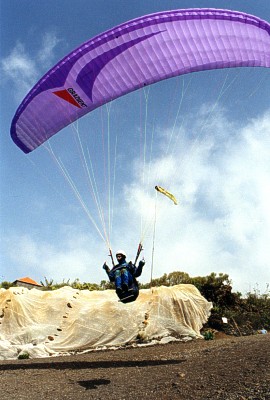
I flew forward a bit and even so I had to lower my ears to maintain the agreed upon photographic height. Before Standa waves me that picture taking is finished, it gets pretty cloudy and within a few moments the wide and strong lifts have dissappeared and in their stead come short, sporadic bubbles. I almost petered out, but pressed close to the wall and after a short skimming of the bank and kicking bananas I got back above the threshold of beautiful riding and occasionally I had to find a down draft in order to maintain an honorable distance from the bases of the not-too-trustworthy cumulous clouds. After a several month long break from flying, I was quite confused by it all, and at times wasn't at all sure if I should be pulling on the steering bars or letting up on them.
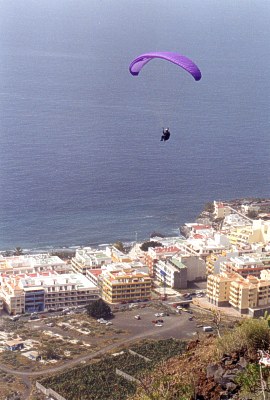
After an hour I tactically "petered out" because I'd had just about enough. During landing, I built up quite a sweat. The landing area is not among the smallest, about 100x500m, but there were enough sun-fried people which had spread out onto the less rocky areas. The black-sand beach radiated two-meter blasts even under the cloudy sky and it was a hard time to hit solid and, mainly, dry ground. Finally I happily landed, and surprisingly at the planned site. Only a few meters over lie the surprised Mila. "You landed next to us on purpose?" he asked. "Of Course" I answered. "I was glad I hit the beach and not the ocean, without also looking to see who's lying where." But Standa who had been waving frantically at me the whole time came running from the opposite end of the beach. He had wanted to photograph my landing. But firstly he'd been standing at a dumb spot and secondly I hadn't noticed him while landing at all. I quickly packed up my paraglider, threw my bathing suit on and hurrah into the ocean!
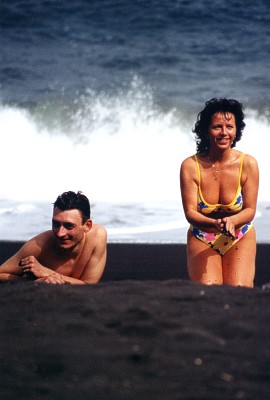
|
Stick the Batteries up Your Butt
The above-mentioned Puerto Naos is the most frequented by tourists place on the island of La Palma. It is actually a tiny village composed of several hotels set between the beach and the wall of a 250m high and several kilometer-long cliffs. Maybe that's why some local flyboys chose this spot and set up a tiny office right by the beach with a wind sleeve on top and the name Palma Club. In the window of their club everyday they put up synoptic maps and weather reports and offer German tourists the opportunity to fly a tandem. They speak seemingly all languages, but Mike speaks the best English. His cell phone number is 0034 09 823 008 and you can also tune him in on the usual frequency here, 143.050MHz.
After lunch you won't see the locals work too much. They hold a kind of "siesta". This title refers to sweet doing nothing, sitting in bars talking about everything, drinking wine, napping on benches and similar activities at a fast, dedicated pace. It's necessary to count on the fact that around this time only some stores are open, services function only partially, and all over in general a sort of afternoon rest dominates. The best place to talk however is in the in front of a bar.
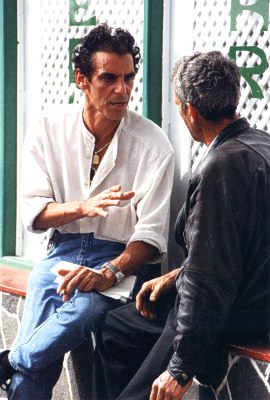
You could really write novels about the local residents. They live in tranquility and absolute harmony. They seem to us to be smiling all the time and very little seems to put them out. A typical example of their mentality is the following case. Several years ago the European Union decided to commit a lot of money to solar street lighting. Over the entire island of La Palma in all the places that the cables of municipal lighting didn't reach, poles with lights and solar batteries were put up. Part of this smart system was a maintenance-free accumulator, which was re-charged by sunlight during the day and at night, powered the lamp. A very nice thing. After several years of operation the battery life was used up and it was time to buy new ones. The EU didn't want to invest more money into the system, as it was already in place and now they wanted the Canarians to care for it themselves. Everyone I'm sure already knows how they reacted. They shined on the batteries from the EU an are in the dark again. Aren't they wonderful?
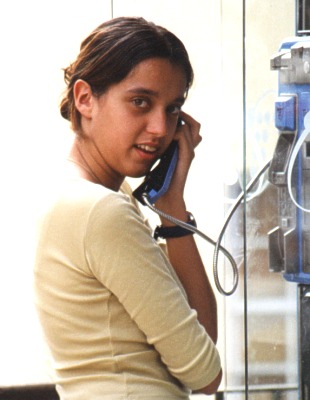
Thanks to the quality roads, which are again the work of the EU, cycling is rather popular on the island. Not that the local residents ride bikes, decidedly not. The Canarians drive cars. Rather, it's the tourists on rented or brought-along-from-Europe bicycles, who happily criss-cross the island. And when they really push the pedals they are able to ride all the way around the island in one single day.
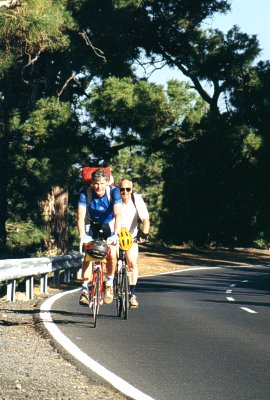
Very interesting, however, is hiking on the island of La Palma. Although our carefully planned-to-the-last-small-detail hike ended up completely different from what we expected, it was decidedly the experience of a lifetime, leaving us with blisters on our feet for the next several weeks.
Ruta de los Volcanes
It didn't take much persuasion on part of the enchanting local mountains to exhort us to hike. We chose the favorite trail, Ruta de los Volcanes, not over mountains and valleys, but, as the name implies, over volcanoes and dells. The trail ended at our house and every evening more or less ruined people with backpacks, hiking shoes on their feet, some better equipped than others, walked by with hiking sticks in their hands.
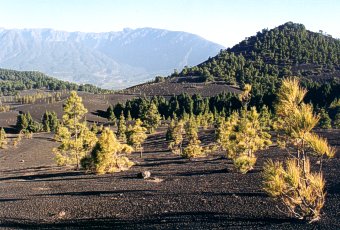
The mountain range crossing the whole island can be divided into three parts: The southern part formed by volcano cones, (the highest peak being Deseada at 1,949m), the central part consisting of a short, connecting crest (cca 1,400m) which in the West turns into the high plain at El Pasa and the northern part with the highest peak on the island, the Roque de Los Muchachos is 2,426m, and has a bit of an alpine character. For our excursion I purchased a map in a scale of 1:50,000 with a hiking guide and satellite photo, for a fair price of 700 pesetas.
|